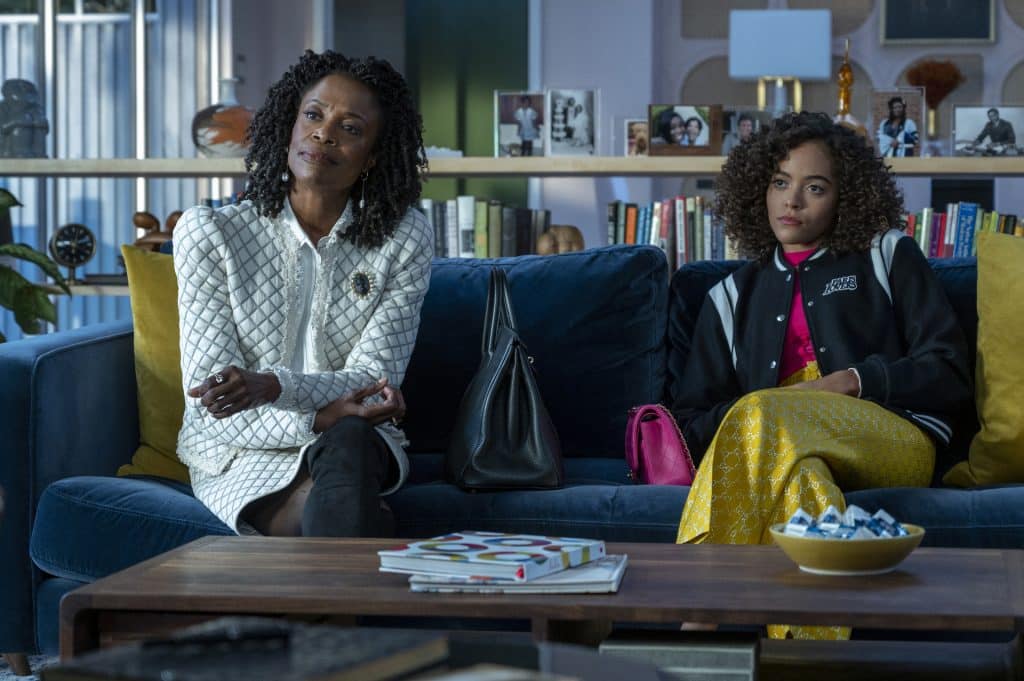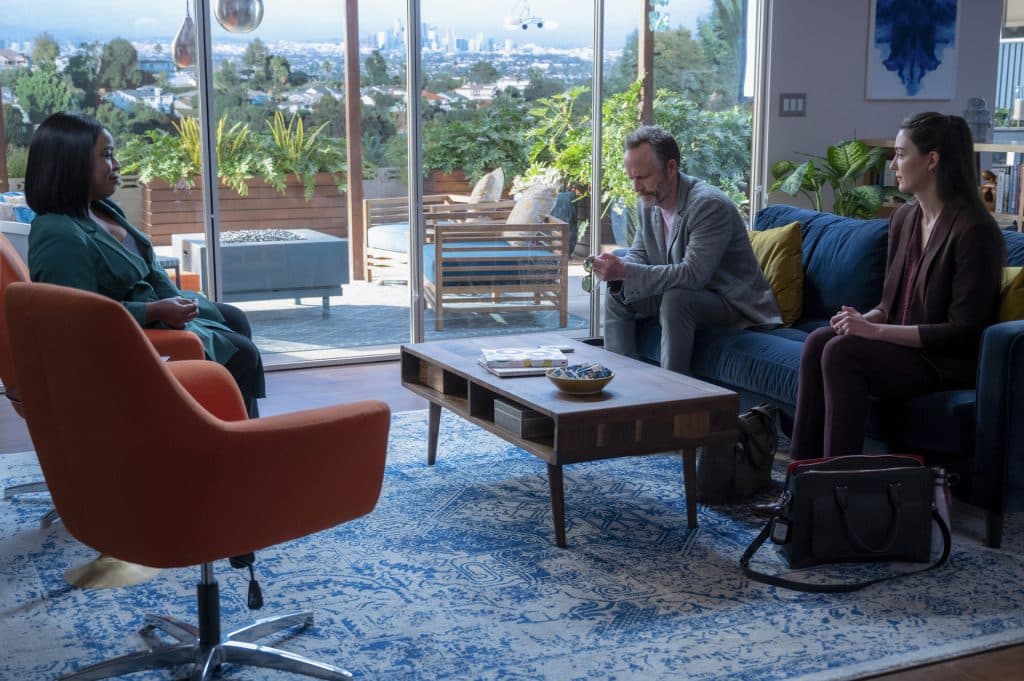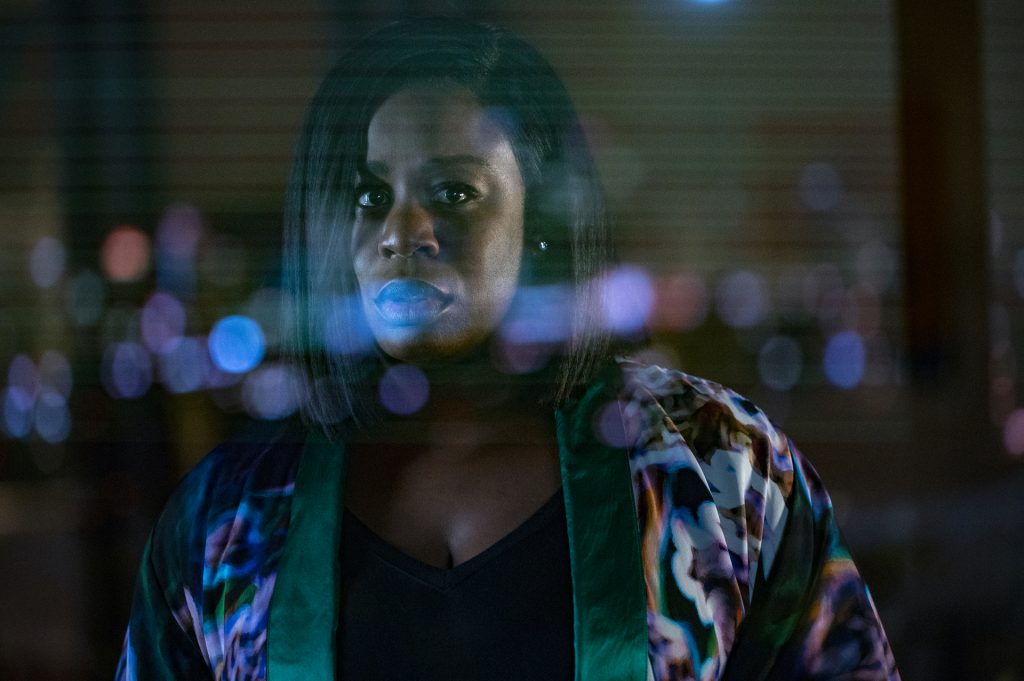Read also:
How to Watch FX Live Without CableHow To Watch AMC Without CableHow to Watch ABC Without CableHow to Watch Paramount Network Without CableThe show’s return finds new complexities, runs into some of the same problems
At The Spool, generally, we try to keep the work front and center. We try to center the work, not ourselves. I say all of that here as a preface because I am both a therapist and a therapy client. I’m reviewing In Treatment as a fictional dramatic work, but I’m also honest enough to acknowledge that framing and guiding some of my opinions will be my own experiences and, while I hesitate to use the term, expertise.
For instance, the blue art piece in Dr. Brooke ’s (Uzo Aduba) home turned therapy space is actually a recolored version of a Rorschach slide and something almost no therapist would display. I promise not to be that granular in general, but I note it now because it provided me an immediate clue that either something was awry with either the show or the character.
[The client sessions] are, by turns, fascinating, frustrating, forlorn, and funny, as real therapy frequently is.
Thankfully after watching 16 episodes of In Treatment Season 4—both a reboot and a part of the same “universe” as the first 3 American seasons—it does seem to be more of a visual clue than a sign that show’s playing fast and loose with the intricacies of therapy.
For those unfamiliar with the first 3 seasons of the HBO adaptation of the Israeli series BeTipul, In Treatment puts you in the room for four weeks of therapy. The first therapist, Dr. Paul Weston (Gabriel Byrne), is out, although the show cleverly places him in a position to cast a shadow throughout. Instead, we’re sitting with Dr. Taylor.
As East Coast elite as Weston was, Taylor is West Coast intellectual. The show smartly delineates the differences in each’s style without tossing a screaming neon sign on it. Additionally, Taylor’s experiences as a person of color draw even starker lines between her and Weston. With her at the helm, the show can go places Weston never could and it gives Treatment new beats and complexities to explore.

Like season 3, we’re following the progression of 3 clients. Eladio (Anthony Ramos), a home health aide with a fondness for literature and romance; Colin (John Benjamin Hickey), a would-be tech mogul who lied his way to riches and then four years in prison for felony wire fraud; and Laila (Quintessa Swindell), a rich teenager whose grandmother, Rhonda (Charlayne Woodard), forces her into therapy for “life skills” and disapproves of her sexual identity. The Day 4 installments of every week are the therapy for the therapist episodes where Brooke struggles with Rita (Liza Colón-Zayas).
As in the Weston-headed incarnation of Treatment, the therapy for the therapist chapters feel like the biggest slogs. They’re true to life insofar as giving therapy to a therapist can be a repeated lesson in power struggles, but it doesn’t exactly make for compelling watching.
There are added under embargo dynamics in Brooke and Rita’s “sessions” that further complicate things for me from a theoretical perspective. Others who do not have the same issues with the philosophy that informs Rita’s approach might feel differently. Colón-Zayas does well finding the steel under Rita’s bluster, there’s just a poison pill in their dynamic that frequently got in the way.

The other three are, by turns, fascinating, frustrating, forlorn, and funny, as real therapy frequently is. The “twists” in the Eladio relationship are the least surprising or interesting, but Ramos is so excellent a viewer is unlikely to care about the predictability. Hickey navigates a character who can be absolutely infuriating well, never shirking away from Colin’s excesses but never making him a cartoon either. Swindell gets better with each episode, spinning up a world of fantasy around herself that seems to be equal parts her savior and her destruction. None of the clients strike a false note throughout.
In a small but important part, Joel Kinnaman plays Adam, a figure from ’s past who threatens her equilibrium despite being seemingly a very well-meaning person. An actor frequently defined by a flat kind of rigidity, Kinnaman makes Adam a figure of tempting ease. While Kinnaman has been good in a few other projects as of late, I can’t think of another time he’s seemed this natural.
None of it hangs together, of course, without Aduba. Taylor has been battered by COVID and twin personal tragedies—one new, one resurrected—and as a result seems to see her home as both a refuge and a prison. At one point, a character encourages her to go out and Aduba gives a subtle full-body tremor that might be fear or repulsion, then immediately masks it with clipped cheerful rejection.
In Treatment has always been an unsolvable riddle though. How do you make a process that’s often measured in metaphorical quarter inches the central drive of a form of entertainment?
While Aduba’s breakout role in Orange Is the New Black gave her a big playground to act in, her role as Taylor lets her capture a lot more shades within a tighter space. When she goes sharp, whether it be with the entitled Rhonda, the enraging Colin, or oblivious Adam, it stings all parties—them, her, and the viewer. There’s a lot of potential wounded healer cliché in Dr. Brooke Taylor that Aduba largely refuses to indulge in, for the betterment of the character and the show.
One cliché the show can’t fully shake is the need to make therapy dramatically satisfying. It’s understandable. This is still entertainment after all. A 100-percent realistic depiction of therapy would be frequently unfulfilling even for someone like me. Still, Treatment’s attempts to give each session a sense of exciting stakes and/or progress is where the show lets its seams show the most.
Every character ends up a kind of fractured mirror of an aspect of Taylor. Eladio seems to be seeking a figure that Taylor’s hungry to satisfy in her personal life. Colin’s ability to both deeply loathe himself and easily let himself off the hook exists within Taylor. Laila’s adolescence sounds a lot like Taylor’s own right down to the external drive to succeed and the scapegoating of sex as the “real” problem. Finally, Rita has gone through a lot of what Taylor feels beaten by but Rita seemingly has everything Taylor feels like she’s missing.

In a novel, it’s the sort of thing that would be great essay fodder. In a show that’s wrestling with its desire to deliver accuracy and dramatic goods, it feels a bit too clean and easy. The clients often end up feeling too smoothed out because they’ve been turned into puzzle pieces to fit into ’s own struggles.
In Treatment has always been an unsolvable riddle though. How do you make a process that’s often measured in metaphorical quarter inches the central drive of a form of entertainment that demands revelations measured in yards and miles? So if it sometimes blinks, cuts corners, or reaches for the incredible instead of sticking to the grind, well, it can be forgiven. It’s an uneasy balance between honesty and entertainment, but In Treatment does it better than any other attempt.
Season 4 of In Treatment premieres on HBO Max May 23rd.